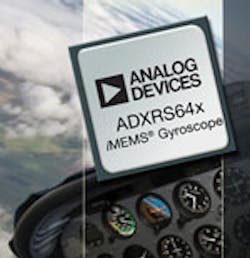MEMS Gyros Deliver Higher Performance Under Harsh Conditions
Analog Devices ADXL64x
The ADXRS64x series of integrated microelectromechanical-systems (iMEMS) accelerometers from Analog Devices offer analog outputs to address the high-performance and low-power requirements of applications demanding exceptional accuracy and reliable rate sensing even where severe shock and vibration are present. The ICs target intelligent agricultural harvesting, surgical navigation, first-responder tracking, factory automation, remote guidance/sensing, and intelligent implements/instrumentation.
The three devices are enhanced versions of and pin- and package-compatible with the company’s ADXRS62x family. The ADXRS642, ADXRS646, and ADXRS649 all feature 10,000-g shock survivability, operate from –40°C to 105°C, and are available in 7- by 7- by 3-mm chip-scale ball-grid array (BGA) packages (see the figure).
“Broadly speaking, low drift (stability), vibration or environmental immunity, and low noise are the three parameters users of high-performance gyros are looking for and our fourth-generation iMEMS sensors we’re introducing meet all these requirements,” says Wayne Meyer, marketing and applications manager for Analog Devices’ MEMS and Sensor Technologies Division.
“These new gyroscopes have linear acceleration sensitivities as low as 0.015°/s/g (a greater than nine-times increase), bias stability of 8°/hour (a greater than three-times increase), and ratio noise density of 0.01°/s/⁄Hz (a six-times increase),” says Meyer, referring to the ADXRS646 versus the earlier version ADXRS62x units as well as other commercially available gyroscopes.
“This family also offers much faster startup times, as fast 3 ms (a greater than 16 times increase), and an angular measurement range of ±50,000º/s (a greater than 66 times increase),” he adds. He also cites the 3.5-mA low power consumption for the ADXL642 and ADXL649. That’s much lower than other units, which consume as much 60 mA.
The highest-performance gyro is the ADXRS646. It features a ±300°/s angular measurement range, bias stability of 8°/hour, and sensitivity to linear acceleration of 0.015°/s/g. Vibration rectification is rated at 0.0001°/s/g2, rate noise density is 0.01°/s/√Hz, and power consumption is 6 V at 5 mA. This unit suits industrial, severe medical-environment, and platform-stabilization applications.
The ADXRS649 offers an even wider angular measurement range of ±20,000°/s, is extendable up to ±50,000°/s with the addition of an external resistor, and offers the fastest startup time on the market of just 3 ms. It also features bias stability of 200°/hour, sensitivity to linear acceleration of 0.1°/s/g, vibration rectification of 0.0006°/s/g2, and rate noise density of 0.25°/s/√Hz. Power consumption is rated at 5 V and 3.5 mA. Applications include sports equipment, industrial, platform stabilization, and high-speed tachometry.
The ADXRS642 is the most basic version in the family. It features a ±300°/s angular measurement range, bias stability of 20°/hour, and sensitivity to linear acceleration of 0.03°/s/g. Vibration rectification is rated at 0.0002°/s/g2, rate noise density is 0.02°/s/⁄Hz, and power consumption is 5 V at 3.5 mA. Applications include inertial measurement units (IMUs), industrial, severe mechanical environments, and platform stabilization.
Key to the ADXRS62x family’s performance is the use of a unique quad differential sensor design. It rejects the influence of linear acceleration and vibration, enabling each gyroscope to offer exceptionally accurate and reliable rate sensing in harsh environments where shock and vibration are present.
The ADXRS646, ADXRS649, and ADXRS642 cost $75.39, $58.59, and $41.85 each, respectively, in 1000-unit lots. Samples and evaluation boards of the ADXRS642 are available now. Full production is scheduled for April. Samples of the ADXRS646 and evaluation boards are also available now with full production scheduled for July. And, evaluation boards are available for the ADXRS649, which is now in full production.
Analog Devices
www.analog.com
About the Author
Roger Allan
Roger Allan is an electronics journalism veteran, and served as Electronic Design's Executive Editor for 15 of those years. He has covered just about every technology beat from semiconductors, components, packaging and power devices, to communications, test and measurement, automotive electronics, robotics, medical electronics, military electronics, robotics, and industrial electronics. His specialties include MEMS and nanoelectronics technologies. He is a contributor to the McGraw Hill Annual Encyclopedia of Science and Technology. He is also a Life Senior Member of the IEEE and holds a BSEE from New York University's School of Engineering and Science. Roger has worked for major electronics magazines besides Electronic Design, including the IEEE Spectrum, Electronics, EDN, Electronic Products, and the British New Scientist. He also has working experience in the electronics industry as a design engineer in filters, power supplies and control systems.
After his retirement from Electronic Design Magazine, He has been extensively contributing articles for Penton’s Electronic Design, Power Electronics Technology, Energy Efficiency and Technology (EE&T) and Microwaves RF Magazine, covering all of the aforementioned electronics segments as well as energy efficiency, harvesting and related technologies. He has also contributed articles to other electronics technology magazines worldwide.
He is a “jack of all trades and a master in leading-edge technologies” like MEMS, nanolectronics, autonomous vehicles, artificial intelligence, military electronics, biometrics, implantable medical devices, and energy harvesting and related technologies.
